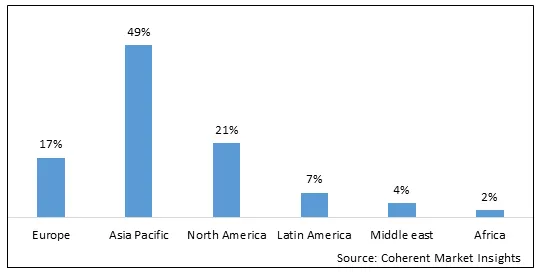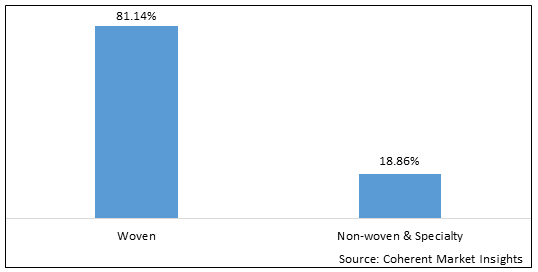Viscose Staple Fiber Market is estimated to be valued at USD 14.00 Bn in 2025 and is expected to reach USD 18.80 Bn in 2032, exhibiting a compound annual growth rate (CAGR) of 4.3% from 2025 to 2032. Viscose staple fiber market is forecast to grow at a high CAGR during the projected period. This growth is attributed to increased demand for textiles and apparels from emerging economies such as the United States, China, Germany, Russia and the United Kingdom. The emergence of social networking sites, apps, and digitalization is also boosting sales of garments and uplifting the demand for viscose staple fiber. Additionally, increasing demand for healthcare and automotive industries is likely to drive the global viscose staple fiber market in the future. Moreover, the growing trend of consuming fast fashion apparel is further expected to drive the global viscose staple fiber market growth in the future.
Global Viscose Staple Fiber Market: Regional Insights
Asia Pacific is the largest market in the global viscose staple fiber market and accounts for a major share in the overall market. The region is expected to witness substantial growth in the future owing to the increased consumption of textile products in India and China.
Europe is the second largest market in the global viscose staple fiber market. The region is estimated to witness significant growth over the forecast period owing to the increase in the consumption of textile products and the growth in the European apparel industry.
North America is the third largest market in the global viscose staple fiber market and accounts for a minor share in the global market. The region is expected to witness substantial revenue from the apparel industry and the growth in the medical sector will also contribute to growth of the market.
Figure 1. Global Viscose Staple Fiber Market Share (%), By Region

To learn more about this report, Download Free Sample
Global Viscose Staple Fiber Market Drivers:
Rise in demand for apparels and clothing in developing countries is propelling market growth
Viscose is an organic liquid extracted from wood pulp and it is useful in the manufacturing of textile and apparel industries. According to the India Brand Equity Foundation, the Indian textile and apparel industry is expected to grow at 10% CAGR from 2019-20 to reach US$ 190 billion by 2025-26. India has a 4% share of the global trade in textiles and apparel.
Growing adoption of viscose fabrics due fluctuating price of cotton
Cotton prices are vulnerable to immense volatility due uncertain climate conditions, along with the supply chain constraints. This compel apparel producers to look for substitutes. According to the USDA (United States Department of Agriculture), in the United States, cotton prices increased by almost 15% in 2017, from the previous year. Hence, fluctuation of prices is witnessed every year in almost every country.
Global Viscose Staple Fiber Market Opportunities:
Growing application of VSF in healthcare sector is expected to present significant growth opportunities. Due to its high moisture and liquids' adsorption and low impurity content properties they are receiving acceptance in the healthcare textile field in recent years.
The product is also gaining popularity in the manufacturing industry. It is a renewable resource and is biodegradable. It is environmentally friendly and helps in reducing greenhouse gas emissions. Additionally, the rising awareness about environment-friendly products has increased the demand for viscose staple fiber. It is also a good alternative to synthetic fabrics and other non-organic materials for manufacturing apparels.
Viscose Staple Fiber Market Report Coverage
| Report Coverage | Details | ||
|---|---|---|---|
| Base Year: | 2024 | Market Size in 2025: | USD 14.00 Bn |
| Historical Data for: | 2020 To 2024 | Forecast Period: | 2025 To 2032 |
| Forecast Period 2025 to 2032 CAGR: | 4.3% | 2032 Value Projection: | USD 18.80 Bn |
| Geographies covered: |
|
||
| Segments covered: |
|
||
| Companies covered: |
Aditya Birla Chemicals, Glanzstoff, Jilin Chemical Fiber Group Co. Ltd, Kelheim Fibers GmbH, LENZINGAG, Nanjing Chemical Fibre Co. Ltd, Sateri, SNIACE Group, Tangshan Sanyou Group Xingda Chemical Fibre Co. Ltd, Xinjiang Zhongtai Chemical Co. Ltd, and Yibin Grace Company Limited (Milan) |
||
| Growth Drivers: |
|
||
| Restraints & Challenges: |
|
||
Uncover macros and micros vetted on 75+ parameters: Get instant access to report
Global Viscose Staple Fiber Market Trends:
Increasing working women population
The growing number of working women has been a driving force for growth of the apparels industry. The increased popularity of fast fashion has also contributed to the demand for apparels. Moreover, increased use of ordinary fibers in the apparel industry is further projected to foster market growth.
Growing production capacity of textile
In February 2020, Indonesia‘s largest integrated viscose rayon production facility was opened in Pnagkalan Kerinci, Riau province of Sumatra. Several senior officials, including Indonesian President Joko Widodo, attended the opening ceremony of the New Asia Pacific Rayon (APR) facility, which is part of the Royal Golden Eagle (RGE). This investment supports both the development of the country’s textile industry and the Indonesian Government’s industrial 4.0 development strategy.
Global Viscose Staple Fiber Market Restraints:
Retaliatory tariff on viscose in the United States
For instance, in 2017, the tariff on viscose staple fiber was 4.3%. Around 41% of the viscose rayon fiber imported into the United States comes from Europe. This step has highly disrupted the industrial supply chain, and has had a detrimental effect on the competitiveness of rayon fiber containing products in the United States.
Competition from synthetic fibers
VSF are costlier than other synthetic fibers, such as polyester, rayon, acrylic, and nylon. Although it is a high-quality material, manufacturing of the fiber becomes limited at times, as the process is expensive.
Figure 2. Global Viscose Staple Fiber Market Share (%), By Segment

To learn more about this report, Download Free Sample
Global Viscose Staple Fiber Market Segmentation:
The global viscose staple fiber market report is segmented into application and geography
Based on Application, the market is segmented into Woven (Including Textile and Apparel) and Non-woven and Specialty (Healthcare, Automotive, Others). Out of which, Woven is expected to dominate the global market over the forecast period and this is attributed to the growing textile and apparel industry.
Specialty (healthcare) segment is also expected to witness significant growth in the near future and this is owing to the growing use of VSF to make aprons, surgical gowns, face mask components, drapes, and wound dressings, among others.
Global Viscose Staple Fiber Market: Key Developments
In March 2018, Glanzstoff Bohemia, owned by Indorama Venture Limited (IVL), further expanded its HT Rayon production.
In April 2018, Kelheim Fibres introduced a new viscose fiber for disinfectant wipes and a range of specialty fibers, at ANEX. The specialty fiber, Danufil QR, is tailor-made for use in disinfectant wipes, an area in which, until now, viscose fibers, in spite of their excellent fluid handling properties, have not been able to establish a foothold.
In March 2018, The Bavarian Viscose specialty fiber manufacturer, Kelheim Fibres, earned the US Department of Agriculture (USDA) certified bio-based product label. The products, DANUFIL, GALAXY, and VILOFT, were then, able to display a unique USDA label that highlighted their bio-based origin.
Global Viscose Staple Fiber Market: Key Companies Insights
The global viscose staple fiber market is highly competitive. This is attributed to continuous launch of new technologies due to ongoing R &D and efforts by value chain participants. Moreover, key players are adopting various business growth strategies in order to expand their presence on regional as well as global basis. Some of the key players in the global viscose staple fiber market are Aditya Birla Chemicals, Glanzstoff, Jilin Chemical Fiber Group Co. Ltd, Kelheim Fibers GmbH, LENZINGAG, Nanjing Chemical Fibre Co. Ltd, Sateri, SNIACE Group, Tangshan Sanyou Group Xingda Chemical Fibre Co. Ltd, Xinjiang Zhongtai Chemical Co. Ltd, and Yibin Grace Company Limited (Milan)
*Definition: Viscose Staple Fiber (VSF) is a highly durable and versatile regenerated cellulose fiber. It is a natural fiber that is produced from wood pulp derivatives such as northern spruce, western hemlock, eucalyptus and southern slash pine. It can be processed into viscose rayon and viscose yarn.
Share
Share
About Author
Yash Doshi is a Senior Management Consultant. He has 12+ years of experience in conducting research and handling consulting projects across verticals in APAC, EMEA, and the Americas.
He brings strong acumen in helping chemical companies navigate complex challenges and identify growth opportunities. He has deep expertise across the chemicals value chain, including commodity, specialty and fine chemicals, plastics and polymers, and petrochemicals. Yash is a sought-after speaker at industry conferences and contributes to various publications on topics related commodity, specialty and fine chemicals, plastics and polymers, and petrochemicals.
Missing comfort of reading report in your local language? Find your preferred language :
Transform your Strategy with Exclusive Trending Reports :
Frequently Asked Questions
Select a License Type
Joining thousands of companies around the world committed to making the Excellent Business Solutions.
View All Our Clients